Weaning our economy off liquid fuels could be impossible, so can we make them without the carbon emissions? Rachel Brazil surveys the scene
On 2 November 2021 at Cotswold Airport near the UK town of Cirencester, Zero Petroleum secured a Guinness World Record for the first flight to be powered by 100% synthetic aviation fuel. The two-seater microlight aircraft was piloted by the RAFs head flight test pilot who reported no differences in how the plane handled. The only differences observed were on the ground. ‘It seemed to be cleaner burning,’ says Nilay Shah, an Imperial College chemical engineer and co-founder of Zero Petroleum. ‘Because it’s a synthetic fuel, it doesn’t have any sulfur or nitrogen in the fuel and it probably doesn’t have some of the species that create partially combusted hydrocarbons.’
Of course, the impetus to develop synthetic petroleum stems primarily from our need to replace fossil fuels and move to net zero carbon energy sources. While technology for battery-powered cars is now well established, ‘I don’t think there’s any realistic expectation of long-haul or heavy aircraft flying on batteries at this point,’ says James Oyler, president of Genifuel Corporation, a US-based company producing synthetic petroleum. Plus, petrochemicals are still used to produce everything from textiles to fertilisers, accounting for 12% of global oil demand.
At one time biofuels were hailed as the solution, but as Anna Krajinska from the Brussels-based cleaner-transport campaign Transport & Environment points out, there just isn’t enough capacity, particularly with growing pressures on food production. ‘If we then scale up the use of those crops, for production of fuels for shipping or aviation, that situation is only going to get worse [and] when you take into account the additional indirect carbon dioxide emissions, from land use change, for example, [biofuels are] no better for the environment than using fossil-based fuels.’
Instead, the energy sector is re-examining some very old technologies for producing liquid fuels that might plug the gap, one of those being the process developed by German chemists Franz Fischer and Hans Tropsch in 1925. They reacted syngas, a mixture of hydrogen and carbon monoxide, at high temperature and pressure to create long waxy linear-chain alkenes, which could then be cracked to form the required chain length for aviation fuel (around eight to 16 carbon atoms). This requires a catalyst, usually cobalt or iron, and was done in huge reactors.
Old tech for a new problem
Over the last decade BP and Johnson Matthey have been working together to improve the Fischer–Tropsch process and to use alternative, sustainable feedstocks such as municipal solid waste or biomass, rather than the conventional coal or gas. Their new reactor and catalyst design provides a step-change in performance, according to BP chemist James Paterson. The key is controlling transport of the gases to the catalyst as well as controlling heat transfer in this highly exothermic reaction. The new design stacks 60–80 catalyst carriers in a radial arrangement.
‘We have evolved the catalyst,’ says Paterson. They have selected 8–10nm cobalt particles embedded in a support. ‘If they’re too big … you end up with a lot of bulk cobalt, which is not on the surface, and then if too small, you end up with a lot of edges and corners, which doesn’t help the carbon–carbon bond formation,’ he explains. The new system has improved selectivity – meaning that at least 90% of the molecules formed have more than five carbon atoms in their chains, maximising the more useful products.
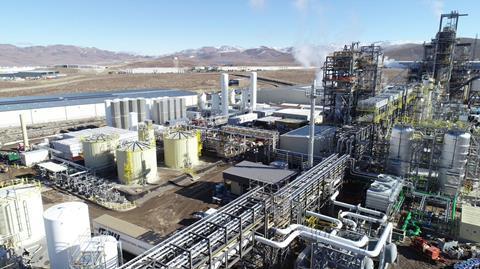
Their improved system is more economical, allowing it to run in smaller reactors. ‘Smaller scale tends to be slightly better for newer areas like biomass,’ says Paterson. The technology is already being scaled up, with US company Fulcrum BioEnergy setting up a first of its kind refinery in northern Nevada that will produce 11 million gallons (50 million litres) of ‘syncrude’ a year from 175,000 tons of gasified municipal solid waste including textiles, wood, paper, residual plastic and packaging materials. This will then be refined into aviation fuel. ‘This is all the landfill waste…and [we are] using that to make this ultra-clean synthetic fuel,’ says Paterson. ‘We’re very excited by this.’
BP and Johnson Matthey are not the only ones who have opted for the Fischer–Tropsch approach, or who are seeking to use waste as a low-cost and circular feedstock. In partnership with British Airways and Shell, the University of Oxford spin-out Velocys is planning to build a facility on the south bank of the Humber river by 2027, which could convert up to 500,000 tonnes of waste into 60 million litres of aviation and road fuel.
E for electrofuels
The fuel Zero Petroleum used in their world-record breaking test flight was also made using the Fischer–Tropsch process. Shah and his partner Paddy Lowe, a former executive director of the Mercedes Formular One team, have taken it one step further. They have developed a direct Fischer–Tropsch process that produces synthetic petrol, diesel, or kerosene straight from the reactor with no need for cracking and only minimal refining. ’Our process avoids making very heavy molecules in the first place, and aims to make products that are already in the right specification,’ explains Shah.
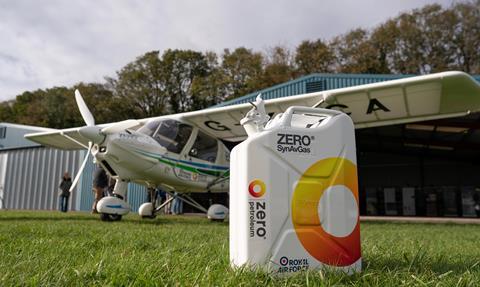
Zero is not disclosing details of its process but it’s based on a series of catalytic conversions that have been fine-tuned to be as selective as possible by modifying the catalysts, the ratio of starter molecules and the temperature and pressure used. ‘The key thing is probably getting the temperature control right … to avoid any big variations in temperature in the system,’ says Shah.
They also plan to make the process fully circular through recycling water and using renewable energy to create their feedstocks – green hydrogen from well-established water electrolysis technology, and carbon dioxide directly sourced from industrial wastes or directly captured from the atmosphere. These kinds of synthetic fuels are sometimes categorised as electrofuels or e-fuels.
The process creates a mix of straight, branched and aromatic hydrocarbons and their recent test flight has shown that they don’t need to blend it with fossil fuels, as is the case with some other synthetic fuels. ‘The branched [and aromatic] molecules help in meeting specifications on density and freezing point and in terms of how the fuel interacts, not with the combustion part, but with other parts of the system like pumps, valves and seals,’ explains Shah.
Under pressure
Getting closer to mimicking fossil fuels is also the intention of Genifuels, who are commercialising hydrothermal processing (HTP) to create synthetic fuel from various waste streams. The method was pioneered by the Pacific Northwest National Laboratory (PNNL) part of the US Department of Energy. ‘In a nutshell, the process works the same way that fossil fuels were formed,’ says Oyler. ‘It uses hot pressurised organic material, generally a waste material, to make renewable crude oil, and renewable natural gas.’ While the natural process of chemically converting organic matter into fossil fuels takes up to 600 million years, Genifuels can do it in half an hour.
Hydrothermal liquefaction oil is generally accepted as being the closest to petroleum
‘Some of the basic principles involved have been known for many years, [but] being able to actually build it economically took a lot of experimentation with materials and construction and design criteria for the various vessels and heat exchangers,’ says Oyler. PNNL began looking at converting waste wood in the 1970s, but it wasn’t until the 2010s that the project took off and is now in the early stages of commercialisation.
Regardless of feedstock, the organic material is turned into a slurry of about 20% dry solids and 80% water which is then subjected to temperatures of typically 350°C at 200 bar pressure through a series of vessels and heat exchangers. ‘Hydrothermal liquefaction oil is generally accepted as being the closest to petroleum or crude oil of all the processes,’ says Oyler. The mix of chain lengths, cyclics, aromatics and phenols makes it more compatible with existing infrastructure. ‘It can be taken into existing refineries, in a very straightforward way, with processes that refiners are already familiar with.’ It’s also about 90% efficient in converting carbon from the feedstock into fuel, with only 10% lost as carbon dioxide; ‘a very good figure for biofuel production,’ says Oyler.
Genifuel is currently focused on using wastewater sludge feedstocks and is setting up a pilot facility in Vancouver that will process 11.4 million litres of sewage sludge per day. But as Oyler says, ‘despite 7 or 8 billion people, there is only enough wastewater sludge to produce at most 10% of the fuels that we use’. Since 2017 they have been running a pilot plant with partners in India processing algae, which can produce up to 2000 litres of biocrude per day. In March they signed a partnership agreement with consulting firm AECOM to harvest harmful algae blooms from waterways as an alternative feedstock.
Bio, but different
First generation biofuels from corn or sugarcane crops may not provide a viable long-term replacement for fossil fuels, but not everyone is counting out biology. LanzaTech, based in Illinois, US, thinks they have a biotechnology solution to making sustainable liquid fuels. ‘We don’t need the land, [we use] less water, and potentially have less impact on biodiversity or indirect land use change,’ says Freya Burton, LanzaTech’s chief sustainability officer.
You’re not limited in feedstock, you could take any waste stream
LanzaTech use ethanol-producing anaerobic bacteria to ferment industrial waste gases. The company was founded in 2005 on the research of their chief scientific officer, Sean Simpson, who has led the development of the biotechnology and gas fermentation scale-up. They are using steel mill waste gas, which is mainly carbon monoxide and cuts out the need for additional hydrogen. Burton says the beauty of the process is that it takes chaos and creates order. ‘It can take wildly fluctuating inputs and create steady continuous streams of product.’
The company built their first demonstration plant in 2008 and now run several commercial plants in China, with many more around the world in the pipeline, including a plant running on old tyres. They are also working with fashion brand Lululemon to include textile waste. ‘You’re not limited in feedstock, you could take any waste stream. But we are very careful that it is a waste stream that has already seen a primary use and the alternative end of life pathway for that waste would be incineration or landfill,’ explains Burton.
The ethanol produced is dehydrated to ethylene which is then oligomerised and saturated to make aviation fuel. ‘This alcohol to jet [fuel] pathway actually can make some of the highest yields of sustainable aviation fuel, up to 90% of the ethanol feedstock.’ The company has spun out LanzaJet, which in February announced the construction of a 120 million gallon (450 million litres) per year integrated sustainable aviation fuel plant in Illinois, using renewable energy and carbon captured from the atmosphere. They have also received a $50 million (£40 million) investment from Microsoft’s climate innovation fund to build a plant in the US state of Georgia, producing renewable diesel from waste-based feedstocks.
Unlike some of the other methods, the biological route also has the potential to bypass the production of petroleum and go straight to some of the chemicals currently made from it. ‘You can actually programme our bacteria to make other chemicals by switching off the ethanol producing gene, which diverts its power to make other things.’ They have identified hundreds of different pathways to chemicals that can’t be made in nature and are already scaling up production of isopropanol and acetone. ‘Today these would only come from fossil pathways, and we’re actually showing that you can make these from waste carbon,’ says Burton.
Tax and laws
Technologies that produce synthetic fuels have clearly arrived, but cost is still a key issue. ‘There’s no process that competes with fossil,’ admits Burton. ‘That’s not going to happen until there’s a real carbon price and the externalities are accounted for.’ According to Tobias Block, head of strategy at the eFuel Alliance, greater adoption of synthetic or e-fuels will need some policy changes. ‘Especially chemists but also engineers who are working on the details of the product sometimes forget what the political landscape looks like,’ says Block. The eFuel Alliance is campaigning for a reduction in taxation on e-fuels. ‘It’s one of the largest economic levers for the development,’ says Block.
Another main issue is creating the demand. ‘Putting a CO2 reduction target on cars has been very effective at putting battery electric vehicles on the road, we need something similar [in the shipping and aviation sectors],’ says Krajinska.
‘In Europe, we fortunately have the Green Deal right now, where all climate regulations are open again … it’s a unique opportunity,’ says Block. This package of policies to stop net greenhouse gas emissions by 2050 will include the renewable energy directives that set usage quotas. The EU has currently proposed a quota of 2.6% by 2030, which the eFuel Alliance would like to see increased to 5% for the transport sector, ‘equal to taking 40 million passenger cars off the road’ according to Block. The UK government has also signalled it is likely to introduce sustainable aviation fuel mandates, but as yet there are no details.
One area where there is not agreement is whether e-fuels should be developed for cars. NGO Transport & Environment is campaigning against incentives that would support this. ‘For cars and for trucks, really electrification is the way forward… we just do not see a role for e-fuels,’ says Krajinska. ‘In the passenger car, using e-fuels is incredibly inefficient: you need five times more renewable electricity than you do if you just electrify the vehicle.’
Synthetic fuel is just such an easy, useful and energy-dense fuel
But the eFuels Alliance see things differently. ‘We have a huge existing fleet of 1.4 billion vehicles with an internal combustion engine, and they won’t disappear overnight,’ says Block. Porsche, in collaboration with Siemens Energy, has set up a pilot project in Chile to make e-fuels, planning to produce 550 million litres a year by 2023. They are making use of the cheap renewable electricity that can be generated in the high winds of Chile’s Patagonia region. ‘That compensates a lot of the efficiency losses that you have which is by far the largest point of criticism for e-fuels,’ explains Block.
If the ultimate goal is to move to hydrogen as the lowest emissions fuel, then synthetic hydrocarbon fuels may just be a stop gap for applications that cannot currently be electrified like aviation, shipping and heavy machinery. But we may be waiting a long time for a hydrogen economy. ‘The problem with hydrogen is that you don’t have any existing infrastructure, it’s not easy to handle it [and] you can’t transport it over long distances,’ says Block. ‘I certainly see us using synthetic fuels up to about 2100,’ says Shah, ‘because it’s just such an easy, useful and energy-dense fuel, and actually very safe.’ Oyler also concludes hydrocarbon fuels may be here to stay ‘for applications that won’t ever be electrified’ even in a carbon-neutral economy.
For now, those involved in developing synthetic fuels are working hard to get both the technology and policy positions right. On the policy side they hope that this year will bring more clarity on EU e-fuels targets which will help to stimulate more investment. With the technology, ‘the priority is increasing the amount of green hydrogen production and the roll-out of direct air capture, to enable the production of fully carbon neutral fuels,’ says Krajinska.
Rachel Brazil is a science writer based in London, UK
Article updated 11 July 2022: LanzaTech would like to clarify that the microbes used to produce ethanol are naturally occurring, not engineered
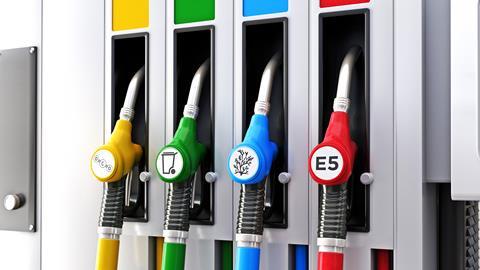


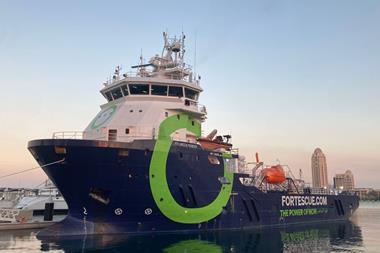

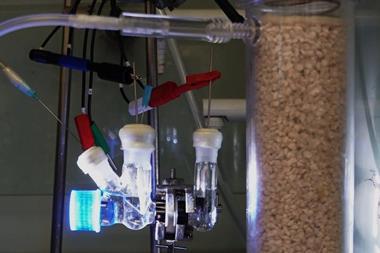
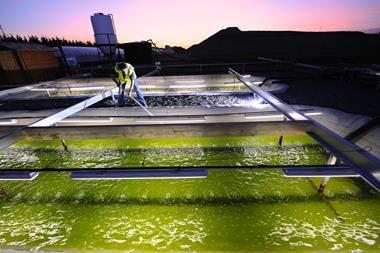



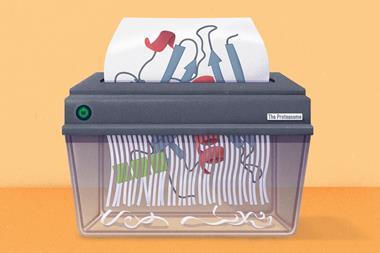


No comments yet